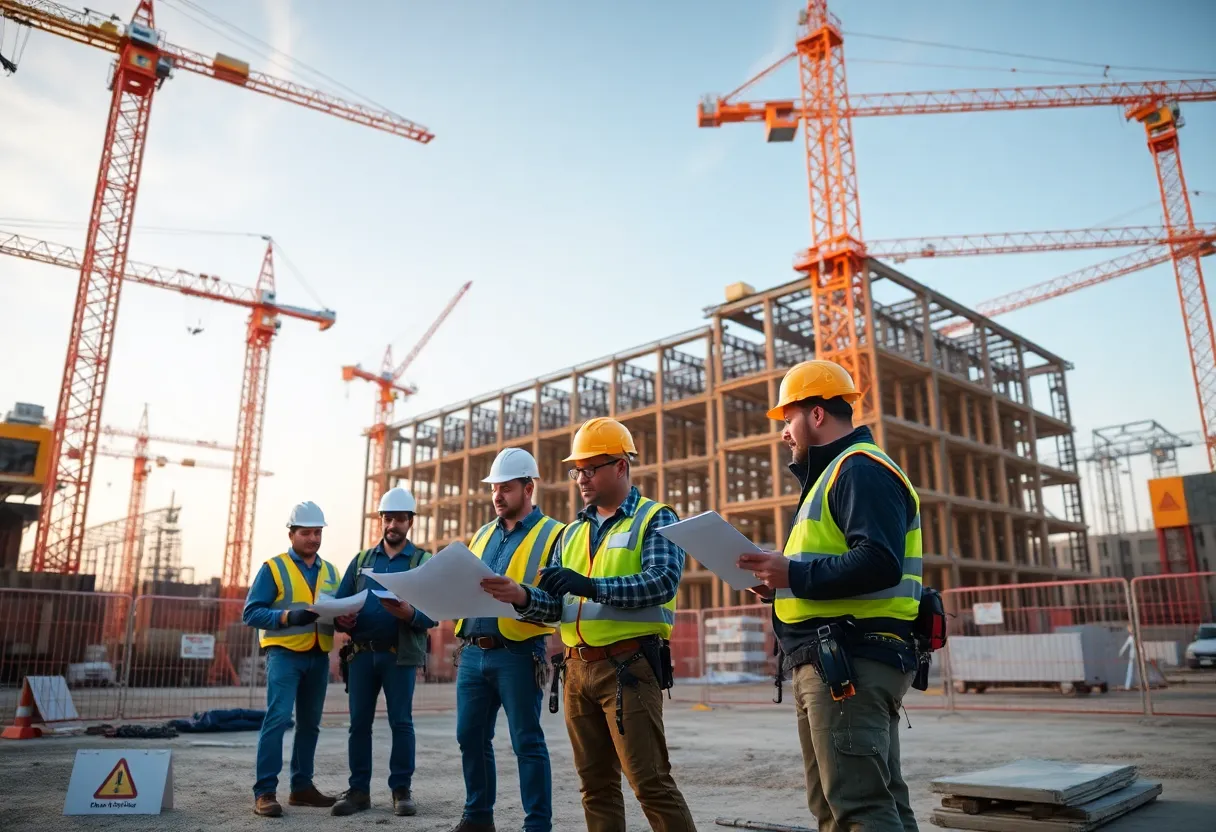United States, August 17, 2025
News Summary
The U.S. construction sector is entering a potentially transformative period fueled by a major federal infrastructure package, rapid clean-energy projects, surging data center demand and new AI-enabled tools. Yet project volume alone won’t ensure success: industry analysis finds the biggest risks are leadership gaps, talent shortages, safety culture lapses and fragile systems that struggle to scale. Firms that invest in leadership development, structured onboarding, safety-led cultures, continuous learning and agile decision-making are better positioned to reduce rework, raise productivity and retain workers while capitalizing on unprecedented opportunity.
Construction poised for a transformative decade — but people, not projects, will decide winners
Top line
Analysis by Brent Gleeson finds the U.S. construction industry entering what could be a transformative decade, fueled by a $1.2 trillion federal infrastructure package, rapid clean-energy rollout, and surging demand for data centers to support the digital and AI economy. Market size projections cited show expansion from $1.77 trillion in 2024 to more than $2.12 trillion in 2025. But the central warning is clear: project volume and backlog alone will not guarantee long-term success. Firms that invest in leadership, talent development, and resilient operating systems will be best positioned to scale and sustain margins.
Why growth will not equal guaranteed success
Growth is arriving with speed and scale. Clean-energy projects, retrofits, and a wave of data center construction require specialized skills, tighter coordination, and higher-capacity logistics. Yet rapid headcount expansion exposes organizational weaknesses. When firms double or triple staff, leadership gaps widen, succession plans often fail to keep pace, and decision-making frequently slows under new bureaucracy. The author frames the central risk this way: long-term performance depends more on people rather than only cranes and concrete.
Leadership, safety and learning as competitive assets
Firms with intentional leadership pipelines enjoy measurable advantages. Research cited indicates organizations with robust leadership development show roughly 1.5 times higher retention and about 29% higher profitability compared with peers that neglect leadership growth. In construction, neglected leadership magnifies consequences because projects are complex, labor markets tight, and safety is paramount.
Safety is recast as a leadership issue. Unsafe environments cost lives and carry heavy business costs: safety-related expenses can consume 6–9% of project budgets. Companies that adopt a safety-leadership culture and empower crews to intervene and report without fear reportedly see incidents drop by 20–50% and gain 15–25% higher productivity, improved morale, and stronger client trust.
Rework remains a major drag, estimated to account for 5–10% of total project costs. The recommended remedy is more learning rather than more oversight. Structured debriefing systems, borrowing from military and aviation practice, create continuous feedback loops. Firms that operationalize structured debriefs and continuous learning report 30–40% reductions in rework.
Agility, culture and retention
Growth often resembles startup-like acceleration with evolving systems and relentless delivery pressure. Rigid hierarchies and silos create drag. Firms that adopt agile leadership practices can experience faster decision cycles and better delivery; cited benefits include 60% faster decision cycles and 30% greater project delivery efficiency.
The talent shortage is an immediate crisis. Nearly 40% of the skilled construction workforce is projected to retire within the next decade. Turnover, when poorly managed, is expensive: replacing a single frontline employee can cost 16–20% of that employee’s annual salary, while replacing mid-level or senior leaders can approach 100% of salary. Small improvements in retention therefore deliver significant financial impact. Structured onboarding and mentoring programs reportedly improve retention by 50% in the first 18 months and accelerate time to full productivity by 20%.
Technology, AI and the rising demand for digital infrastructure
Advances in technology and artificial intelligence are reshaping design, management, and delivery. The digital economy is driving a surge in data center development, demanding massive investments in high-capacity facilities. This trend interacts with an influx of projects from infrastructure spending and clean-energy initiatives, creating both opportunity and strain on talent, logistics, and insurance markets.
Insurance and market moves
Insurers and brokers are adjusting leadership and capacity to match market shifts. A major privately held brokerage aligned practice leaders across transportation, energy, marine, life sciences, healthcare, and construction to deepen industry specialization and tailored solutions. Another global firm added senior leaders to accelerate construction, infrastructure, and surety practices in North America, signaling prioritization of the sector at scale.
Specialized insurers describe evolving product portfolios. Marine insurance now often covers inland risks, contractors’ equipment, domestic transportation, warehousing via stock throughput products, and even data center exposures tied to AI infrastructure. Market trends driving demand include rising vessel and goods values, global supply chain complexity, and large insured limits for petrochemical and LNG cargoes.
Talent and personnel updates from the field
Large contractors are promoting experienced leaders into district and regional posts to guide rapid expansion. Examples include appointed district managers in Pacific Northwest, Midwest, and Rocky Mountain regions, with responsibilities spanning commercial, residential, aviation, manufacturing, civic, renewable energy, and mission-critical work. These moves reflect a broader push to stabilize leadership on the ground while scaling operations.
Bottom line
The pipeline of projects looks deep, but the greater risk is lack of leadership, culture, and systems to execute at scale. In an environment of slowing growth rates, rising costs, and fierce competition, the decisive edge will be the human side of the business. The path forward is clear: leaders must invest in people beyond technical execution and go beyond the blueprint by embedding leadership competencies, safety-first cultures, continuous learning, and clear career pathways across every layer of the organization.
FAQ
What is driving near-term construction growth?
A large federal infrastructure package, accelerated clean-energy initiatives, and a surge in data center construction to support AI and the digital economy are primary drivers. Market projections show rapid expansion from 2024 into 2025.
Does more backlog mean a company will succeed?
Not necessarily. Backlog and projects create opportunity but expose firms to leadership, safety, and operational risks. Success depends on people, systems, and culture as much as project volume.
How important is leadership development?
Very important. Firms with strong leadership pipelines show higher retention and profitability. Leadership development that spans executives to front-line supervisors is crucial for safety, efficiency, and scaling.
How can construction firms reduce rework?
Implement structured debriefs and continuous-learning systems to capture lessons, standardize improvements, and reduce errors. Case examples show significant reductions in rework when these practices are operationalized.
What workforce challenges should firms plan for?
A large share of skilled workers will retire in the next decade, and replacing employees can be costly. Firms should invest in onboarding, mentorship, career pathing, and culture to retain younger workers who value development opportunities.
How are insurance markets responding?
Brokers and insurers are reorganizing leadership and expanding product portfolios to cover inland marine, stock throughput, data centers, contractors’ equipment, and complex builders’ risks to meet the changing risk landscape.
Key features at a glance
| Feature | Summary | Impact |
|---|---|---|
| Market drivers | Federal infrastructure spending, clean energy, data centers, AI demand | Large pipeline of projects and investments |
| Growth projection | Industry projected from $1.77T (2024) to >$2.12T (2025) | Accelerated hiring and scaling pressure |
| Leadership & talent | Investment in pipelines, onboarding, mentoring | Higher retention, profitability, and safety |
| Safety | Leadership-driven safety culture reduces incidents | Lower costs, higher productivity, better reputation |
| Insurance and risk | Product expansion into inland marine, stock throughput, data center coverage | Broader risk-transfer options for complex projects |
| Operational fixes | Structured debriefs, continuous learning, agile leadership | Reduced rework, faster decisions, improved delivery efficiency |
Deeper Dive: News & Info About This Topic
Additional Resources
- Forbes: 5 Big Reasons Leadership Effectiveness Is Imperative in Construction
- Wikipedia: Construction industry
- Lockton: Lockton Appoints U.S. Leaders in Key Industry Verticals
- Google Search: Lockton appoints U.S. leaders in key industry verticals
- Risk & Insurance: Aon Announces New Leadership in Construction and Surety Practice in North America
- Google Scholar: Aon construction and surety leadership North America
- PR Newswire: PCL Construction Announces Leadership Changes to Support Strategic Growth
- Encyclopedia Britannica: PCL Construction
- Turner Construction: Turner Wins 2024 Leadership Award from U.S. Green Building Council
- Google News: Turner wins 2024 leadership award US Green Building Council
Author: Construction CA News
The CALIFORNIA STAFF WRITER represents the experienced team at constructioncanews.com, your go-to source for actionable local news and information in California and beyond. Specializing in "news you can use," we cover essential topics like product reviews for personal and business needs, local business directories, politics, real estate trends, neighborhood insights, and state news affecting the area—with deep expertise drawn from years of dedicated reporting and strong community input, including local press releases and business updates. We deliver top reporting on high-value events such as the Rose Parade, Coachella, Comic-Con, and the California State Fair. Our coverage extends to key organizations like the California Building Industry Association and Associated General Contractors of California, plus leading businesses in technology and entertainment that power the local economy such as Apple and Alphabet. As part of the broader network, including constructionnynews.com, constructiontxnews.com, and constructionflnews.com, we provide comprehensive, credible insights into the dynamic landscape across multiple states.




